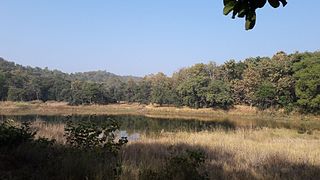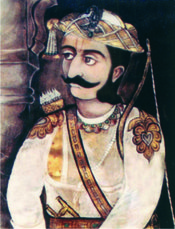Related Research Articles

Gondwana, also known as Gondaranya, is a region of India, named after the Gondi people who live there. The name of the ancient continent of Gondwanaland was derived from Gondwana, because some of the earliest rock formations of this continent were first investigated in part of the region, in modern Odisha.

Balaji Bajirao, often referred to as Nana Saheb I, was the 8th Peshwa of the Maratha Confederacy in India. He was appointed as Peshwa in 1740 upon the death of his illustrious father, the Peshwa Bajirao I.

The House of Bhonsle are a prominent Indian royal house. They claimed descent from the Sisodia Dynasty, but were likely Kunbi Maratha.

Seoni District is a district of Madhya Pradesh state in central India. The town of Seoni is the district headquarters.

The Kingdom of Nagpur was an Indian kingdom in the 18th and 19th centuries. It came under the rule of the Marathas of the Bhonsle dynasty in the mid-18th century and became part of the Maratha Empire. The city of Nagpur was the capital of the state.
The Haihaiyavansi Kingdom was a kingdom which consisted of the central part of the present-day state of Chhattisgarh located in India. According to a popular theory, the Haihayavanshi kingdom consisted of thirty-six garhs or feudal territories, and hence, the region of Chhattisgarh was named after the number of forts it had. In 1740, the Maratha general of Nagpur, Bhaskar Pant conquered the kingdom for Raghoji I Bhonsle. The Raipur branch of the kingdom survived until 1753, also being annexed by the Marathas of Nagpur.

Raghoji I or Raghuji the Great of the Bhonsale dynasty, was a Maratha general who took control of the Nagpur Kingdom in east-central India during the reign of Shahu I. His successors ruled the kingdom until 1853.

Raghuji Bhonsale II or Raghuji II Bhonsale was the Maratha ruler of the Kingdom of Nagpur in Central India from 1788 to 1816.

Narnala Fort or Narnala Qila Sarkar, also known as Shahnoor Fort, is a hill fortress in the Satpura Range of Vidarbh, Maharashtra, India, named after the Rajput Solanki Chalukya Ruler, Raja Narnal Singh, also known as Narnal Singh Swami. It was renamed as "Shahnoor" by Islamic rulers but again acquired, rebuilt and got its name "Narnala" by ruler Rao Rana Narnal Singh Solanki, who migrated from Patan in Gujarat.
The Battle of Pachgaon was fought on 26 January 1775 for accession to the throne of the Nagpur Kingdom in central India. Mudhoji Bhonsle killed his brother and rival Sabaji, securing the undisputed regency for Mudhoji's infant son Raghoji II. The battle ended a struggle begun when their brother, the ruler Janoji Bhonsle, died in 1772 after adopting Raghoji II as his heir.

Bakht Buland Shah was a ruler of the Rajgond dynasty. He added to his kingdom, the territories of Chanda and Mandla, and portions of Nagpur, Balaghat, Seoni, Bhandara and the adjoining Rajput kingdom of Kherla/Khedla. The present districts of Chhindwara and Betul also fell under his control. A great warrior, he went on to conquer Pauni, Dongartal, Sivni & Katangi.

Raghuji Bhonsle III or Raghuji III Bhonsle, was the Maratha ruler of the Principal States of Nagpur in Central India from 1818 to 1853.

Chand Sultan (1706-1739) was a Muslim king of Nagpur. He was the eldest son and successor of Bakht Buland Shah of Deogarh. He ascended the throne of Deogarh in 1706 and shifted his capital from Deogarh to Nagpur. He carried out further reforms in his kingdom and planned layout of the new city of Nagpur and under him, the kingdom prospered. He was a kind ruler who loved his people and extended his territory considerably to the east of the river Wainganga.
Gondwana Kingdom was the ruling kingdom in Gondwana region of India. The Gondwana region includes core region of eastern part of the Vidarbha of Maharashtra, Garha Kingdom the parts of Madhya Pradesh immediately to the north of it, and parts of the west of Chhattisgarh. The wider region extends beyond these, also including parts of northern Telangana, western Odisha and southern Uttar Pradesh.

The Bhonsles of Nagpur were a Maratha royal house that ruled the Kingdom of Nagpur from 1739-1853. They hailed from the Bhonsle clan of Marathas and were one of the most important and powerful Maratha chiefs in the Maratha Empire.

The Gonds of Deogarh were a Gond royal house that founded and ruled the Nagpur Kingdom before being practically being made state pensionaries by the Bhonsle Maratha leader Raghoji I Bhonsle. They made Nagpur a prosperous and plentiful kingdom, founding the city of Nagpur and building further infrastructure. However, internal bickering led to their downfall.
Bhaskar Ram Kolhatkar, known as Doshyu (Dacoit) Bhaskar Pandit by the people of Bengal, was a Maratha general and statesman. He was the dewan of the raja of Nagpur, Raghuji Bhonsle. He played an important role in the kingdom of Nagpur's expansion. The first Maratha invasion of Bengal in 1741, as also the third in 1744, was led by him. He was an able military leader, proven by his success in the Maratha invasions of Bengal and conquest of Chhattisgarh. He was killed by Alivardi Khan on 30 March 1744.
The Kingdom of Chanda was one of the main Gond kingdoms, ruling parts of central India. In 1751, it was conquered by the Maratha ruler of Nagpur, Raghoji I Bhonsle.
Mohan Singh was the last ruler of the Haihaiyavanshi Kingdom, the dynasty which ruled Chhattisgarh for over 700 years. He ruled Chhattisgarh under the suzerainty of the Bhonsles of Nagpur Kingdom.
Baka Bai was a Maratha stateswoman and favourite wife of Raghoji II Bhonsle, the king of Nagpur. After her husband's death, she played a key role in the intrigues at the royal court of Nagpur.
References
- ↑ Host Bibliographic Record for Boundwith Item Barcode 30112050248951 and Others. 2013.
- ↑ Maharashtra State Gazetteers: Bhandara district. Directorate of Government Print., Stationery and Publications, Maharashtra State. 1979.
- ↑ Maharashtra State Gazetteers. Directorate of Government Print., Stationery and Publications, Maharashtra State. 1979.
- ↑ The History and culture of the Indian people. Bharatiya Vidya Bhavan. 1977.
- ↑ "The Gazetteers Department- Chandrapur". Cultural Maharashtra Government.